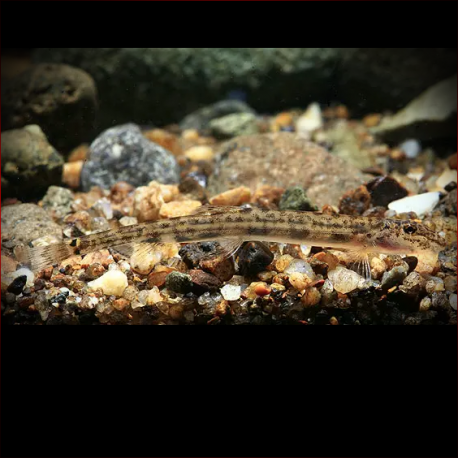More info
Datasheet
| Minimum Tank Size | 60 litres / 15.85 US gallons |
| Maximum Size | 5.0cm / 1.97inches |
| Temperature | 20°C / 68.00°F - 24°C / 75.20°F |
| Hardness | 1.01dgH / 18ppm - 10.03dgH / 179ppm |
| pH | 5.5-7.0 |
General Description
Acanthopsoides Molobrion is a species of loach closely related to horse-faced loaches, commonly known as "dwarf horse-faced loaches." The genus comprises five species, with distinctive features such as mid-dorsal markings and caudal-fin bands. They share a basic patterning of blotches extending from the snout to the caudal peduncle, with variations in size and number between species. These loaches possess chromatophores in their fins, forming bands that differ in shape and number. Acanthopsoides are typically small, slender-bodied fish with unique characteristics distinguishing them from similar genera like Acantopsis and Somileptes. The family Cobitidae, to which they belong, is distributed across Eurasia, with Acanthopsoides forming a separate genetic lineage within the family.
Aquarium Setup
Setting up an aquarium for Acanthopsoides Molobrion requires a tank with a minimum size of 60 litres. These loaches thrive in soft, sandy substrates where they can burrow. Coarse gravel should be avoided, as it may cause stress or hinder their natural feeding behavior. Providing water-worn rocks, driftwood, and ample hiding spots is essential. Dim lighting is suitable unless incorporating live plants, and adding leaf litter can enhance their environment. Due to their preference for sluggish waters, high flow rates should be avoided, although oxygenation is recommended. Additionally, securing the tank to prevent jumping is advised.
Behaviour
Acanthopsoides loaches are known for their peaceful nature, showing no signs of aggression towards tankmates, including small, schooling cyprinids. They are highly gregarious and thrive best in groups of six or more. The presence of peaceful upper-water column dwellers can reduce their timidity, as these loaches associate the absence of such fish with potential danger. Care should be taken in selecting tankmates, avoiding overly territorial or aggressive species, especially sand-dwelling loaches from specific families.
Feeding and Diet
Acanthopsoides Molobrion feed by sifting mouthfuls of substrate through their gills, extracting insect larvae, small crustaceans, and similar prey. Offering a varied diet is crucial, including sinking dried foods, live, and frozen options like Artemia, Tubifex, Daphnia, and bloodworms. Providing a diverse range of foods ensures proper nutrition and mimics their natural feeding habits in the wild.
Reproduction & Dimorphism
Breeding of Acanthopsoides loaches in aquarium settings is rare, with limited documented instances. Successful breeding has been reported in controlled environments, with fry observed in tanks housing adult pairs. Mature males exhibit enlarged pectoral fins with extended, thickened second rays and breeding tubercles, while adult females are typically larger and heavier-bodied than males. These physical differences help differentiate between the sexes.
Habitat and Distribution
Acanthopsoides Molobrion primarily inhabit flowing, clear-water river channels with sand, fine gravel, or mud substrates. They are commonly found in groups, with population sizes varying among species. Their distribution spans regions in Indonesia, Malaysia, and parts of southern Thailand. Sympatric occurrences with congeners like A. robertsi have been observed in specific river basins, highlighting their preference for similar habitats within their range.

